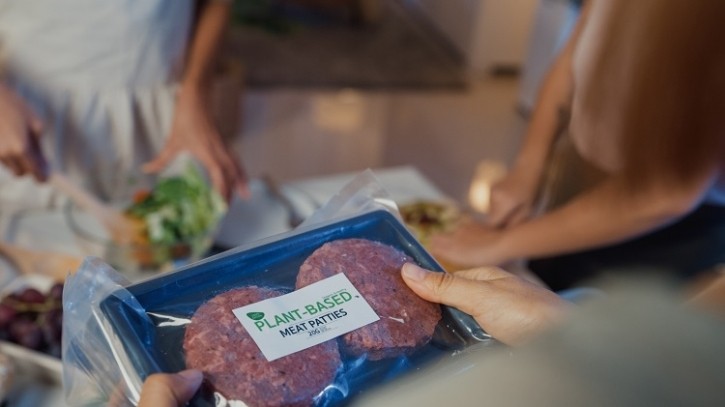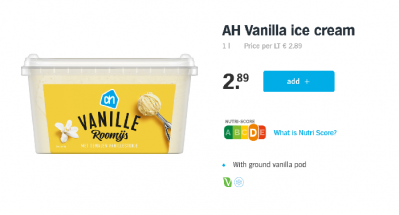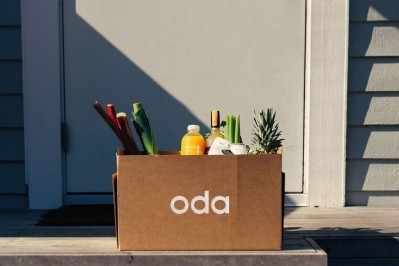A world first: How Albert Heijn shares climate footprints to the ingredient level

The Netherlands’ largest supermarket retailer has committed to cutting greenhouse gas (GHG) emissions by 45% by 2030 compared to 2018 levels, and to achieving net zero by 2050.
This requires first understanding the carbon footprint of its own range, per product, before working to reduce its impact. But at the same time, the Ahold Delhaize-owned supermarket chain says it wants to increase its transparency for customers and stakeholders.
In a bold move, Albert Heijn has become the world’s first grocery retailer to share ingredient-level product climate footprints for more than 1,000 of its private label food and drink products, which helps consumers better understand the CO2e impact of their purchases.
Albert Heijn measures cradle-to-shelf, not cradle-to-grave
Albert Heijn is not the first grocery retailer to start communicating about the CO2e impact of its food and beverage products, but it is the first to do so based on ingredient-level impact assessments (rather than category average values).
To determine a product carbon footprint (PCF), Albert Heijn uses specific data about its production chains, suppliers and processes, as well as generic data such as country or sector average values – both at the product level. “We use specific data from our suppliers as much as possible, because it reflect the actual climate impact of our own products,” explained the retailer.
As to which metrics it uses to assess a PCF, Albert Heijn follows the European Commission’s Product Environmental Footprint (PEF) method. The PEF Directive uses 16 different environmental impact areas, including energy use, water consumption, and contribution to climate warming.
But Albert Heijn’s approach differs from the PEF in that it does not measure all phases of the product lifecycle (known as cradle-to-grave). Because the retailer is not fully including the use and waste phase, it’s measuring cradle-to-shelf.

Why? The company explained it wants to represent its products’ carbon footprint at the time of purchase. “In addition, we have no insight into how the consumer will use and/or prepare the product."
How did Albert Heijn gather data for its product climate footprints?
To calculate its PCFs, Albert Heijn draws on specific and generic data, both with the help of external parties.
The retailer has partnered with food safety and quality group Mérieux NutriSciences to help calculate PCFs based on specific data from its supply chains. That means collecting data from not just the retailer, but from its suppliers, farmers, and growers.
Albert Heijn is also working with Austrian AI-powered start-up Inoqo to calculate PCFs based on generic data. The start-up has developed a database detailing life cycle assessments (LCAs) of various foodstuffs, cradle-to-grave. The database includes more than 160 crops from around 200 areas and factors in details about associated agricultural practices. Food

processing methods is also incorporated, from drying fruit to producing vegetable oil.
Using Inoqo’s data helps the retailer to assess a large number of products in a relatively short period, explained Albert Heijn sustainability manager Jens Gronheid. “Inoqo’s methodology enables us to provide an increasing amount of primary data over time, which is crucial to identify further opportunities to reduce the impact of our products.”
Which food and drink products are being assessed?
Albert Heijn is calculating the carbon footprint to the ingredient level for 1,100 of its private label food and drink products. For more than 125 of those, the retailer has calculated the PCF based on specific methodology (in collaboration with Mérieux NutriSciences).
PCFs based on specific methodologies are available online and on-pack for a number of products with its pork, chicken, eggs, salmon, and meat substitutes ranges.
The company told us the introduction will be ‘gradual’. “More and more products will be added in the coming period. The emissions are stated on the products in the form of a small informative cloud with the CO2e emissions per kilogram of product.”
Not the first grocery retailer to assess, but the first to share
Albert Heijn is not the first grocery retailer to assess its product carbon footprints to the ingredient level, but is the first to share its findings.
Last year, Norwegian online grocer Oda tied up with Inoqo to assess the product CO2e footprint of its 6,600-strong food and drink product range.
Read more about the collaboration here: Inoqo inks deal with Norway’s largest online grocer
As of last month, PCFs based on generic data (developed in collaboration with Inoqo) are now available for more than 1,000 own-branded products online, including foods and drinks within the pasta, breakfast cereals, soft drinks and juice, nuts, and confectionery ranges.
“We are introducing something quite unique, innovative, and straightforward: a score that reveals the climate impact of products…” explained sustainability manager Gronheid.
“It provides a detailed insight into how each food and beverage product contributes to climate change.”




























